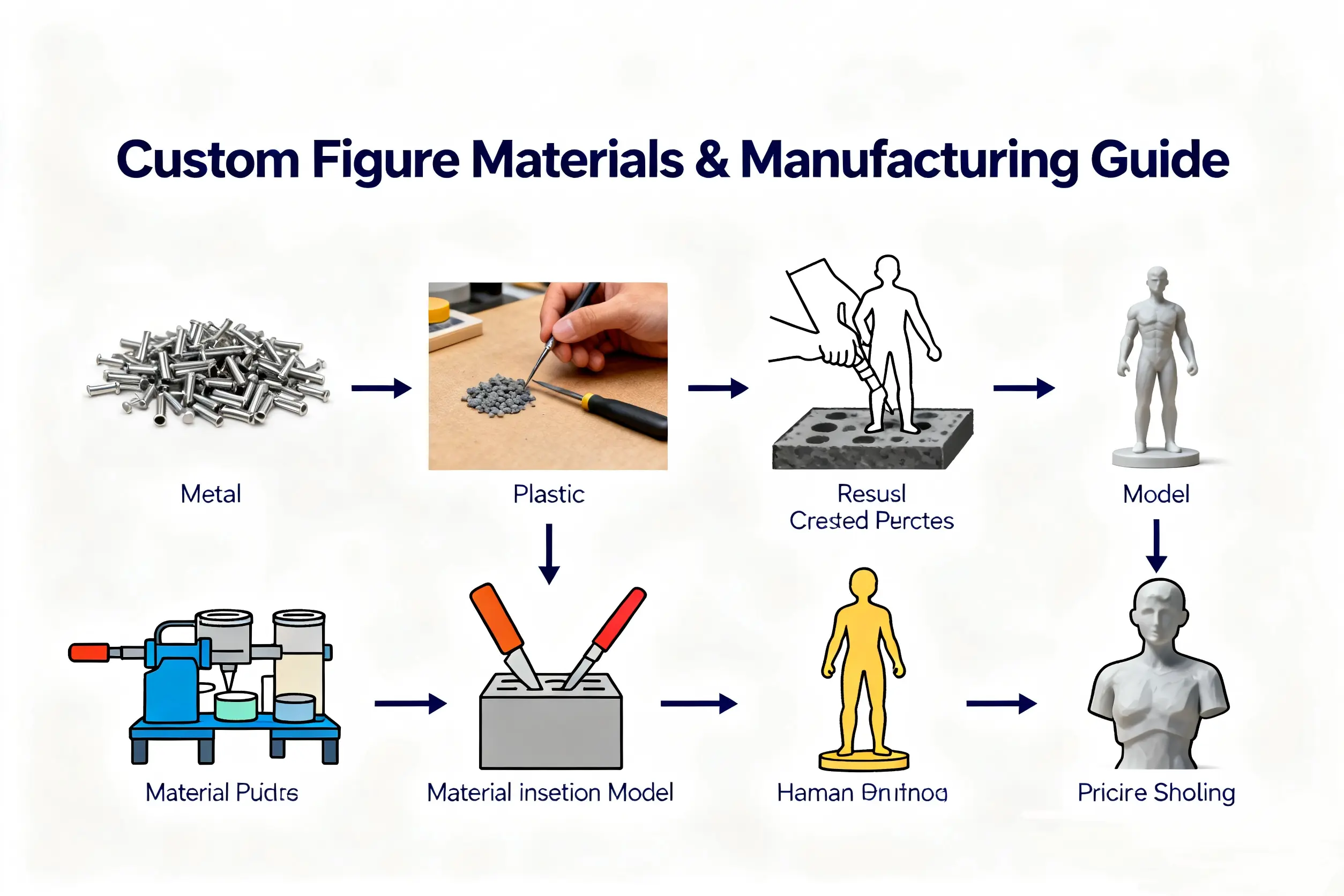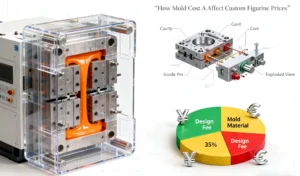When beginners start exploring how to choose the best material for custom figures, compare PVC vs resin, or understand the basics of vinyl toy manufacturing, they often find the information scattered, technical, and difficult to apply to real projects. If you’re new to the custom toy industry—whether you’re creating your first prototype or preparing for a small production run—this guide will walk you through all essential materials and manufacturing processes in a simple, practical, and beginner-friendly way. Our goal is to help you choose the right approach, avoid unnecessary costs, and build a solid foundation for your first successful custom figure project.
I. Introduction: Why Materials and Processes Matter
If you are new to the custom toy and figure industry (0–1 year), one of the first challenges you’ll face is choosing the right material and manufacturing process.
You may be wondering:
- “Should my figure be made of resin or PVC?”
- “Is vinyl too expensive?”
- “What’s the most cost-effective option for my MOQ?”
The truth is:
Your material + process choice directly determines the price, quality, durability, and production time of your custom figure.
This guide will help beginners quickly find the most suitable option with clear explanations and practical examples.
II. The Most Common Materials for Custom Figures (Pros, Cons, Costs)
1. PVC — The Most Stable and Popular Material for Mass Production
PVC is the most widely used material for commercial figures.
Key Features:
- Good detail reproduction
- Highly durable and impact resistant
- Excellent for mass production
- Consistent quality
Cost:
Higher mold cost but lower unit price. The more you produce, the cheaper it gets.
Best For:
1,000+ pieces
Brands and IP projects
Figures with joints or multiple parts
Beginner Tip:
Minimize the number of separate parts if your budget is limited—every additional part requires its own mold.
2. Resin — High Detail, Perfect for Small Batches
Resin is ideal for highly detailed collectible pieces.
Features:
- Highest detail level
- Ideal for hand-painting
- Heavy and premium feel
Drawbacks:
- Fragile
- High manual labor
- Not cost-effective for large orders
Best For:
50–200 pcs
Art toys
Display statues
Kickstarter or test markets
3. Soft Vinyl — The Favorite Material for Designer Toys
Features:
- Lightweight
- Not easy to break
- Smooth and rounded texture
- Affordable even for large sizes
Limitations:
Not suitable for sharp details or complex joints.
Best For:
Designer toys
Blind box series
Cute or stylized figures
4. ABS, Metal Parts, and Hybrid Materials
These structural materials are used for:
- Joints
- Support areas
- Weight-bearing parts
If your figure requires stability, articulation, or heavy accessories, combining PVC + ABS or PVC + metal inserts is common.
III. Common Manufacturing Processes (How They Affect Quality & Cost)
1. Injection Molding — Best for PVC/ABS
Advantages:
- Highly stable quality
- Low unit cost
- Ideal for mass production
Disadvantages:
- High mold investment
- Not suitable for low MOQ
2. Rotational Molding — For Soft Vinyl / Designer Toys
Features:
- Classic soft vinyl process
- Produces hollow, lightweight figures
- More forgiving for large-size toys
3. PU Resin Casting — For Small Batches
Features:
- No need for expensive steel molds
- Highest detail
- Perfect for low quantities
Drawbacks:
- High manual labor
- Unit price can’t drop much
4. 3D Printing — For Prototypes and Samples
Perfect for:
Concept validation
First prototype
Kickstarter presentation
But not used for mass production.
IV. How to Choose the Best Material + Process (Beginner Framework)
Use this 4-step selection framework:
Step 1: MOQ
- 1–200 pcs → Resin
- 200–500 pcs → Resin or Vinyl
- 500–1000 pcs → Vinyl
- 1000+ → PVC injection molding
Step 2: Budget
- Low → Vinyl or simplified PVC
- Medium → PVC
- High → Resin
Step 3: Style
- Cute, round, stylized → Vinyl
- High-detail, realistic → Resin
- Commercial retail → PVC
Step 4: Size & Weight
Larger sizes → vinyl
Smaller sizes → PVC or resin
V. How to Reduce Costs Without Sacrificing Quality
✅ 1. Simplify structure (fewer mold parts)
Fewer parts = lower mold cost.
✅ 2. Reduce paint complexity
Paintwork can be 25–40% of production cost.
✅ 3. Reduce overall size
Smaller size = lower material + packaging + shipping cost.
✅ 4. Use universal joints
Custom joints add unnecessary cost.
✅ 5. Plan packaging early
Oversized packaging increases shipping costs dramatically for overseas projects.
VI. Common Beginner Mistakes (Avoid These Pitfalls)
❌ Thinking resin is “better” than PVC
(They serve different purposes.)
❌ Skipping prototype validation before mold making
❌ Designing overly complex internal structures
❌ Ignoring packaging size during development
VII. Conclusion: Choosing the Right Material = Half of Your Success
Your material and process choice affects every stage—from production cost to shipping safety.
If you’re new to the industry, remember:
Small batch → Resin
Designer toys / blind boxes → Vinyl
Large commercial orders → PVC
Not sure → Ask an expert
Need Help Choosing the Best Material for Your Project?
If you’re unsure what fits your design and budget, feel free to share:
- Your design file or sketch
- Desired quantity
- Target size
- Budget range
We’ll recommend the most cost-effective and reliable solution based on your needs.
Choosing the right material and manufacturing process is one of the most important steps in creating a custom figure that is both cost-effective and true to your original design. Whether you’re producing a small batch of resin art toys, a soft vinyl designer series, or a large PVC commercial run, planning your materials early will help you avoid costly revisions and keep your project on schedule.
If you are new to the toy manufacturing field, don’t feel overwhelmed—every successful brand started with the same questions you’re asking now. With the right guidance, you can confidently bring your character, mascot, or IP figure to life.
If you’re unsure which material or production method fits your figure, feel free to reach out.
Share your design, quantity, size, and budget, and our engineering team will help you evaluate the most efficient and cost-appropriate solution.
📩 Contact MIHOX
Email:stella@newmiho.com
Website: https://newmiho.com/
Tell us more about your idea—we’re here to support you from prototype to mass production.




